The door issue in shooter design
Let's say I'm creating a level for a classic first-person shooter. First I build an arena and add some monsters to it. I don’t want the player to be attacked immediately after the start of the level, so I attach a corridor to one of the sides of the arena and put the player there.

The letters E are the monster enemies in the arena, and the letter P is the player who is originally in the corridor.
My level turned out to be simple, but I am pleased with it and invite my friend to test it. My friend walks down the corridor, enters the arena and the monsters find him - while everything is going according to plan. Then my plan begins to collapse. Instead of fighting in the arena, my friend returns to the corridor and shoots at the door when enemies appear in it one by one. Instead of a dynamic shootout, dodging bullets and a whirlwind of destruction, my friend turned the level into a shooting gallery: boring, safe and slow.
This is the so-called door problem . In particular, this is the problem of doors in the design of combat clashes. This is the problem of attracting players to the gameplay spaces and forcing the game to be fun.
If the problem is at the door , why not make it bigger, or connect the corridor to the arena directly? But the problem is not in the door itself. The problem is the relationship of these two spaces, the problem is what the player experiences when he crosses a threshold, which often takes the form of a door.
If we expand the doorway so that the corridor opens onto the arena, we will get a different version of the same problem. In some ways, it will be better, in something worse. Even after increasing the threshold, nothing still draws the player into the arena, and nothing in the hallway pushes him out.

Before considering ways to solve this problem, let's figure out what and why is going wrong.
Let's start with the basics. When we make a level for a classic first-person shooter, what do we create? If we omit the thematic and narrative functions of the level, then what is the meaning of the level? What are we trying to build by creating a combat design?
Building a level for a classic shooter is not about killing scary monsters with powerful guns, although this is part of the appeal of the game. In addition, the level of a classic shooter is not just a sequence of keys and locks. All these are means to achieve the goal, and the goal is control over the map. When a player moves on a level, he takes the territory of the enemy and puts the level into a resolved state.
This battle for territory is one aspect of map control, but there are others. In an abstract sense, control over a card is a player expanding his abilities and narrowing down his opponent's capabilities. These capabilities depend on resources, including on the position on the map, as well as on health, items, and ammunition. For example, if a player has health and ammunition, then he can break through the battle through a dangerous space to a more advantageous position, exchanging it for resources. Without resources in the form of health and ammunition, he does not have such an option.
And vice versa - when a player dies, this is partly due to the fact that he lost the game of control over the map and he has run out of options. Of course, in first-person shooters, attention is also important, prioritization between goals and the player’s ability to learn gameplay patterns. If a player dies, the reason for this also lies in his poor skills and inaccuracies. But when the player gets comfortable with these basics, the game more and more depends on the control over the map.
In the event of a combat collision, control of the map implies an understanding of the relationship between enemies, the environment, and available resources. For the player, control of the map means reducing the chances of attack for enemies, as well as increasing the number of ways to attack them¹.
What is meant by control over a card in case of my level with a door problem? When my friend first entered the arena and aroused enemies, he had a choice:
This choice depends on a few unknowns. If a player is fighting in the arena, and enemy reinforcements arrive, then the player can be crushed and instead it is worth fighting near the door. Or if a player does not have enough firepower to kill enemies as they get closer, then he will run out of options and die in the corridor. The choice depends on the player’s understanding of the game and the conventions of its level design.
Card control games can be described as position graphs with attention to the positions that the player can attack.
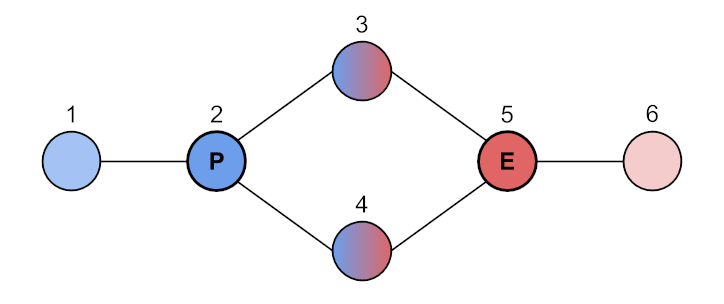
The player takes node 2, controls node 1 and can attack nodes 3 and 4. The enemy takes node 5 and controls node 6.
And here is a simplified version of my level with a door problem:
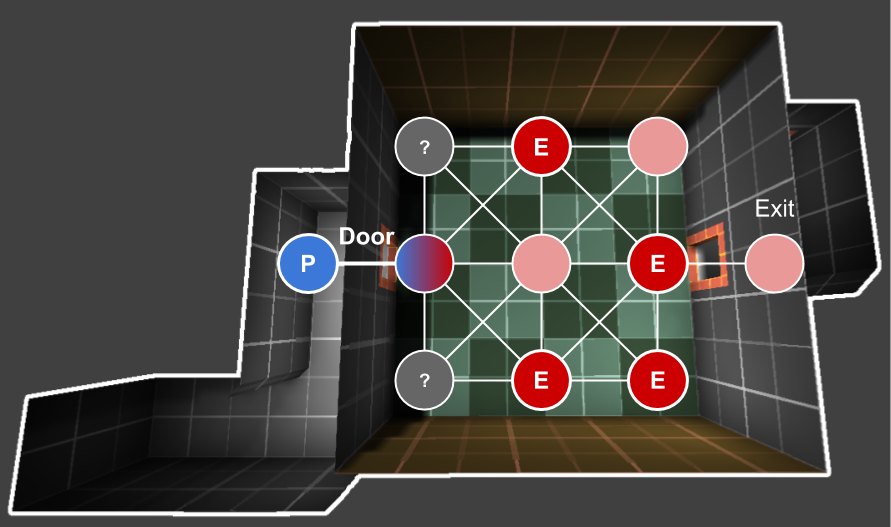
The letter P denotes the position of the player, the letters E indicate the position of the enemy. The sign "?" unknown information marked.
This abstraction shows us that once in the arena, the player finds himself under a large number of attack angles, which he will not be able to cope with. For a successful battle in this arena, the player needs a deep understanding of the behavior of AI and game mechanics. So instead, most players will fight out the door.
Another way to diagnose door problems is through value charts. This is a tool for abstract analysis of the player’s perception of a level, assigning values and forming plans².
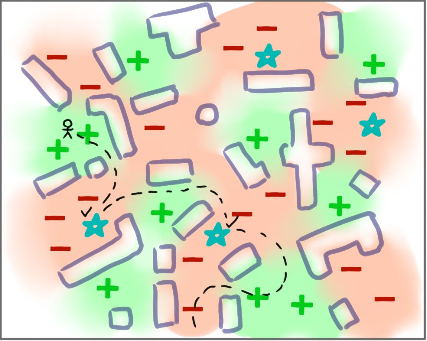
A value diagram from Aubrey Serre's report on nonlinear level design at GDC 2019.
To create a value chart, you need to consider the mechanics of the game and analyze how the geometry of the levels supports or weakens them. In the case of shooter gameplay, convex corners create reliable shelters; they provide an opportunity with minimal risk to go out, take a shot and come back. Other types of level geometry, such as dead ends or kill zones, can scare away players because they limit the player’s ability to move and shoot without taking damage.
In the gameplay of shooters, the value of the geometry of the levels changes when the player and enemies move and shoot. In addition, the value varies depending on the types of enemies and various gameplay systems. If a player sees a monster shooting galloping grenades, then he needs to perceive the level differently; shelter, which was reliable against enemies with direct combat weapons, is now more dangerous than open spaces.
Such dynamics are pushing for the style of the game, which Matthias Worch called “prioritization choice” in his report at the GDC 2014 “Meaningful Choice for Game Level Design ”. Warch gave this definition to the choice of prioritization: "the complex interaction of systems that are easy to understand individually, but combined to create situations that do not have constant or obviously winning tactics." This means that the player has to form opinions on the best plan for solving this dynamic environment.
In other words, in the gameplay of shooters, the value chart describes a specific moment of perception and evaluation of the player. At another moment, the arena is moving and the value chart may become different, with new threats and other priorities.
If we apply these diagrams to my level with the door problem, then we will understand what is going wrong. The whole space of the arena repels the player with his vulnerability and suspense. The corridor, by contrast, provides cover in which the player can safely attack this group of enemies.
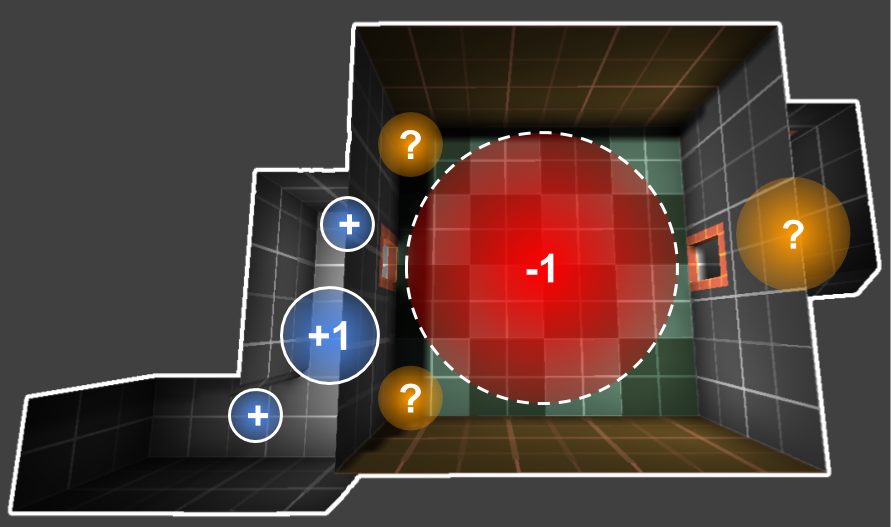
This value chart tells us what we already know. But looking at the level in terms of player perception and evaluation, we can understand how to solve the door problem. If I want my friend to fight in the arena, then I need to change the level geometry so that the space is more positive and attractive than the battle behind the doors.
Now that we have learned about the concept of control over a card and got acquainted with value charts that allow us to understand how a player evaluates a level, let's look at several methods for solving the door problem. This list is not complete, but may be a good basis.
The simplest solution is to add shelter. This is a strong position that attracts the player to the arena. From this position, the player can further delve into the arena for battle. The only reason the player will now want to return to the doorway is because the shelter is too open or the simplicity with which enemies can surround the shelter and push the player back.
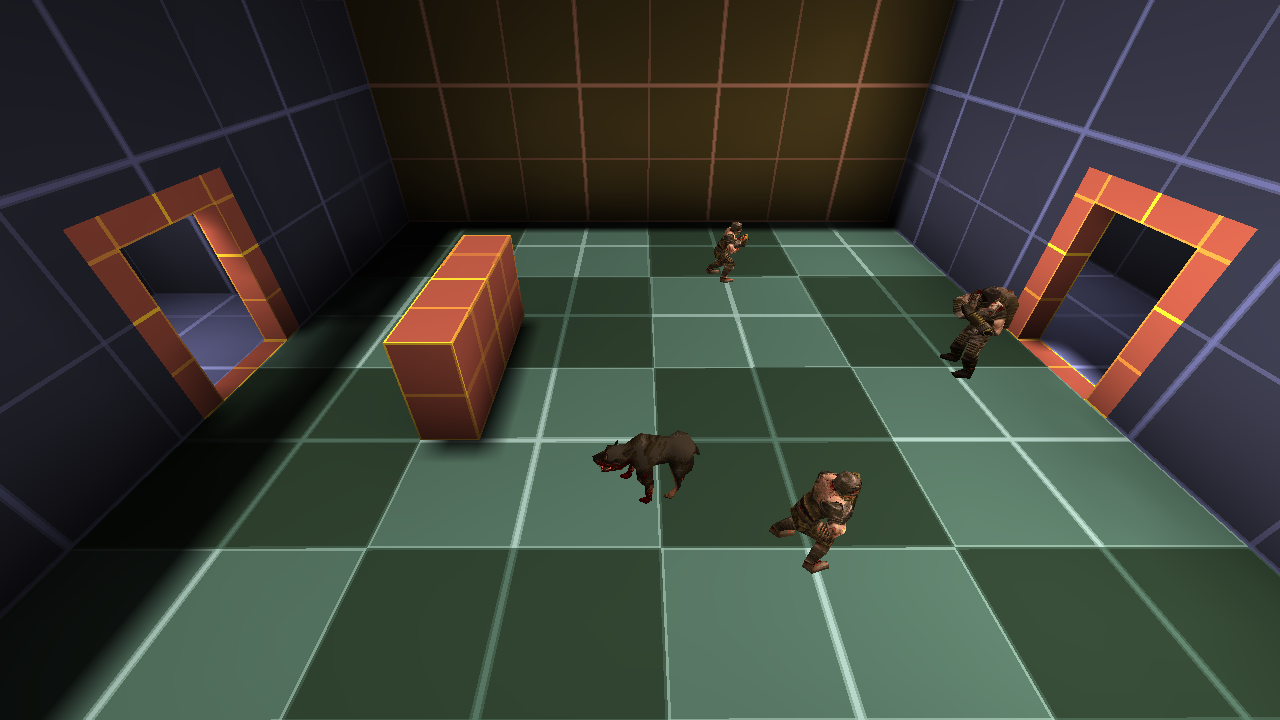
Here, the support is a simple unit providing complete shelter. The player cannot see enemies from the back of the block and beyond its edges.
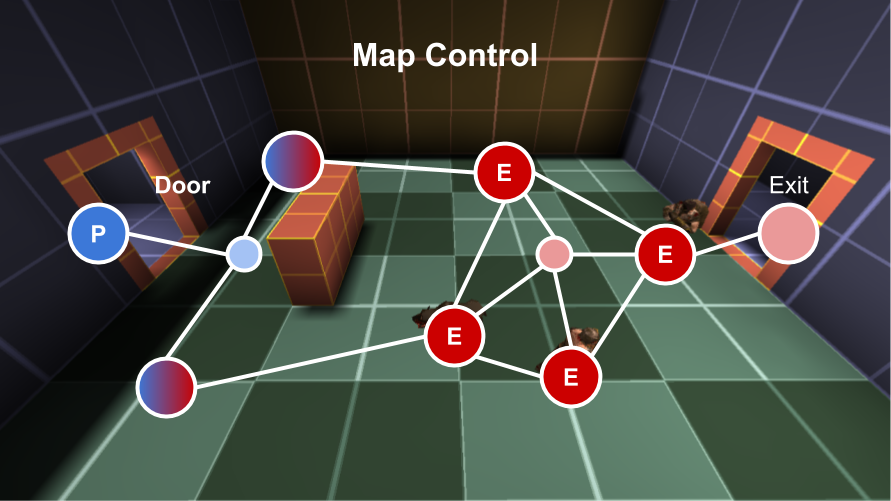
We see that from the point of view of control over the map, the shelter limits the angles of attack for enemies and simplifies the player’s analysis of the arena.
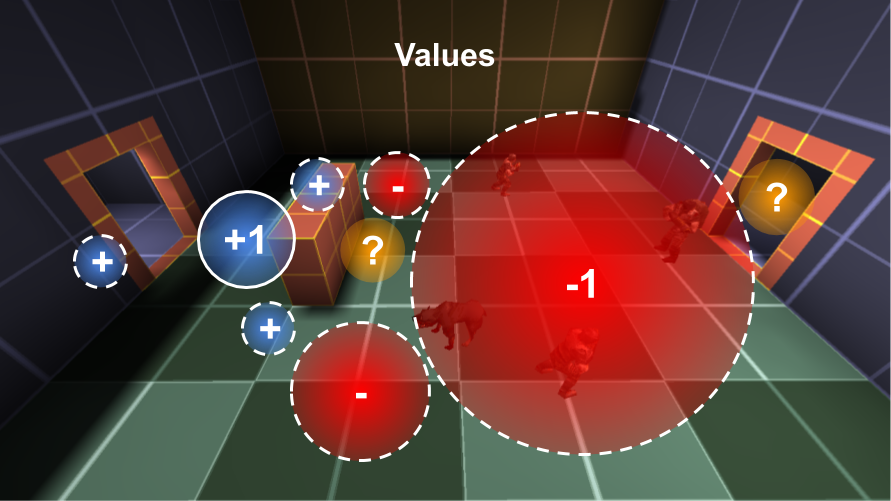
From the point of view of the value chart, we see how this supporting shelter draws the player into the arena.
In addition, we can influence a player’s assessment of a level using powerups and items. Placing a powerful reinforcement artifact in the center of the arena can attract a player and make him take a risk.

However, after gaining power, the player no longer has reasons to stay in the arena, and he may want to return to the corridor. Although this depends on the amplification effect, usually this technique is not enough to solve the door problem.
Another problem with this technique is that we can only give the player reinforcement from time to time. If, while in the corridor, the player still has gain from the previous arena, then gain from the new arena will not be especially valuable to him.
In card control games, one of the tactics used is divide and conquer. We can push players to use this tactic by breaking the arena into layers. After dividing the arena, there will no longer be a position from which everything is visible - the player will have to move in order to know where the enemies are.

Walls hiding information also act as islands of shelters that can draw a player into the arena. When the enemies learn about the presence of the player and the battle begins, these walls become the player’s control over the battle.
In such schemes, information becomes another resource for controlling the card. The player can pay with his time and position to get information, or pay ignorance to stay in place. Even when there are no monsters in a closed, fragmented arena, the player may be alarmed by hidden information and this encourages him to explore the space to control this information. From the point of view of the value chart, this anxiety has an averaged negative value with small areas of positive space in the corners of the shelters that attract the player.
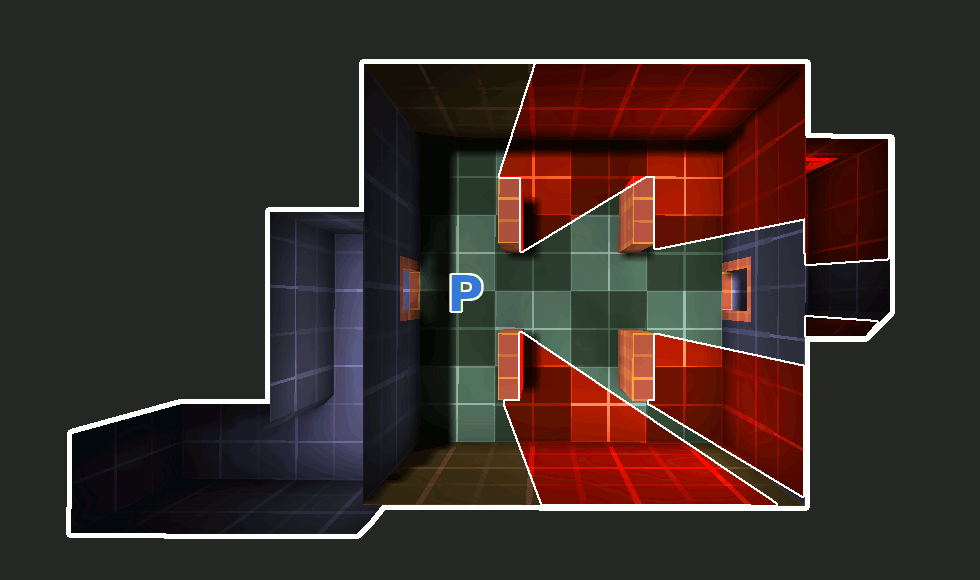
Also, hidden information prevents the player from retreating. If in this example the player retreats into the corridor, then he will give control over the card to an unknown group of enemies; there may be more enemies in the arena than the player can withstand fighting against them in the doorway. The retreat does not allow you to take advantage of improvisation opportunities that appear when revealing hidden information.
One aspect of the door problem at my level is that enemies start to run towards the player and limit his movements. You can change the geometry of the arena so that the enemies remain on the islets of the territory, tied like a dog to a booth. This means that the player will have to go on the offensive, and not wait for the enemies to get through the door one by one.

At the levels of a classic shooter, the simplest way to deter enemies is to use a height difference. In some games, the AI cannot jump down or climb up to a height of more than one step, that is, enemies are limited to one island and can only attack. In modern games, there are more diverse tools for influencing AI behavior, for example, zones, volumes of protected spaces, weight of paths and scripts³.
As with the risk reward methodology, AI restrictions are not enough to solve the door problem. This technique should be used in combination with other techniques for attracting a player to the arena.
To make the player fight in the arena, we can use more powerful methods. You can make the player fall down or close the door behind him. The player can enter the room through a one-way elevator or teleport.
In modern games, you can enable the cutscene, taking the moment to develop the characters and remind you of the player’s goal, while closing the passage to the previous area of the level. But in classic first-person shooters, players expect secrets and rewards for exploring levels. In this context, one-way passages violate familiar conventions and deny the possibility of player influence. When using this technique in this context, you need to open new paths to go back or create loops.
Having understood what the problem is, and having learned some of the methods for solving it, we can put it all together.
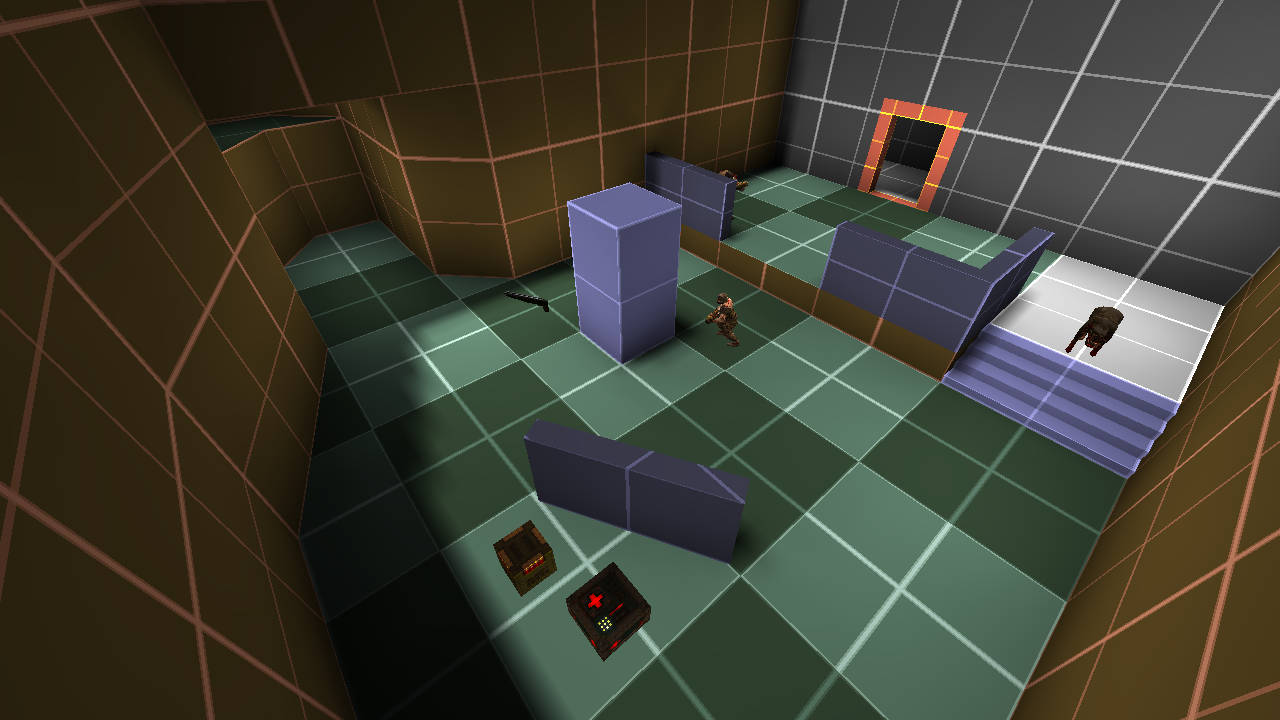
Without changing the number of enemies and not greatly increasing the size of the arena, I used the following methods:
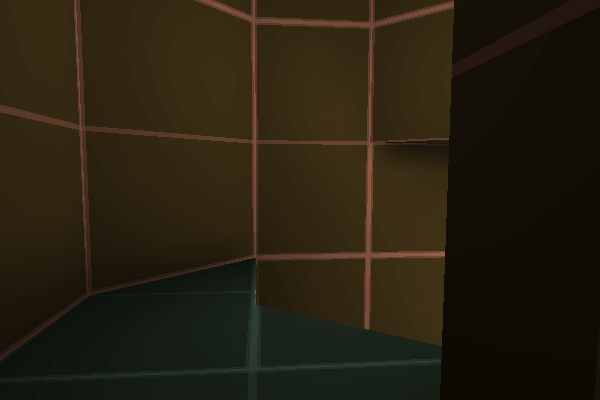
My example that I used in this post may seem like a novice designer problem. Of course , everyone knows that there should be shelters in the arena! Of course , you need to divide the arenas into layers of hidden information!
But this door problem remains relevant. My last map for Quake suffered from a door problem that occurred several times there. At each new level being created and in every combat clash, I think about how to draw the player into the right space and how to solve the door problem.
I want my players to interact with a deeper map control game. I want to give them the opportunity to choose prioritization, create plans and tactics, rather than reduce the gameplay to shooting at a shooting range.
I hope this article helps you find door problems in your own work, and the techniques described will prove useful in solving these problems.
[1] If you want to better understand the concept of map control, I recommend watching the Rapha versus Cooller match at Quake Live: https://youtu.be/XdkDjsBiO58?t=155 . What seems like a game of reflexes, attentiveness and accuracy, becomes a game of tactics. Although this is a multiplayer match, the concept of control over the card applies to it. The main difference is that we design single-player battles in such a way that players can solve them, like chess problems .
[2] The concept of value diagrams appeared in a report by Randy Smith at the 2006 GDC “Level Building for Stealth Games” . For the first time I learned about these diagrams under the name of “Theory of Significance” from “Dark Pasts (Part 4)” by Robert Yang, where he analyzed the design of game levels of the immersive sim genre. In his report “Radically Nonlinear Level Design” at the GDC 2019, Aubrey Serre adapted Smith diagrams to the design of action games.
For more information about the influence of a player’s perception on his movement inside the arena, see Blake Rebush’s “Balancing Action and RPG in Horizon Zero Dawn Quests” report from GDC 2018. A particularly interesting part starts from the 15th minute when he begins to describe the design of the bunker.
[3] You can learn more about modern techniques for creating AI for battles from a report by Matthew Gallant at the GDC 2017 on the manual and system AI in Uncharted 4 .

The letters E are the monster enemies in the arena, and the letter P is the player who is originally in the corridor.
My level turned out to be simple, but I am pleased with it and invite my friend to test it. My friend walks down the corridor, enters the arena and the monsters find him - while everything is going according to plan. Then my plan begins to collapse. Instead of fighting in the arena, my friend returns to the corridor and shoots at the door when enemies appear in it one by one. Instead of a dynamic shootout, dodging bullets and a whirlwind of destruction, my friend turned the level into a shooting gallery: boring, safe and slow.
Problem Illustration (GIF) 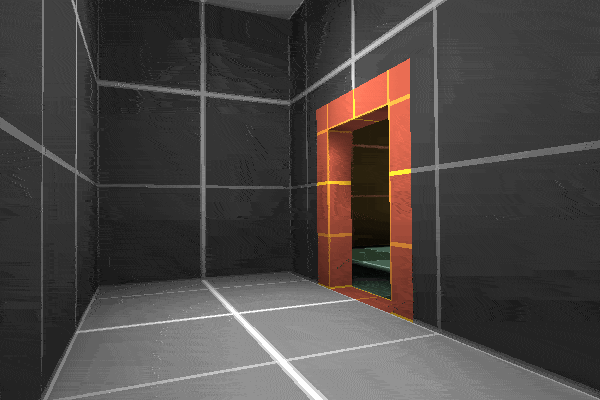

This is the so-called door problem . In particular, this is the problem of doors in the design of combat clashes. This is the problem of attracting players to the gameplay spaces and forcing the game to be fun.
If the problem is at the door , why not make it bigger, or connect the corridor to the arena directly? But the problem is not in the door itself. The problem is the relationship of these two spaces, the problem is what the player experiences when he crosses a threshold, which often takes the form of a door.
If we expand the doorway so that the corridor opens onto the arena, we will get a different version of the same problem. In some ways, it will be better, in something worse. Even after increasing the threshold, nothing still draws the player into the arena, and nothing in the hallway pushes him out.

Before considering ways to solve this problem, let's figure out what and why is going wrong.
What am I actually creating?
Let's start with the basics. When we make a level for a classic first-person shooter, what do we create? If we omit the thematic and narrative functions of the level, then what is the meaning of the level? What are we trying to build by creating a combat design?
Building a level for a classic shooter is not about killing scary monsters with powerful guns, although this is part of the appeal of the game. In addition, the level of a classic shooter is not just a sequence of keys and locks. All these are means to achieve the goal, and the goal is control over the map. When a player moves on a level, he takes the territory of the enemy and puts the level into a resolved state.
This battle for territory is one aspect of map control, but there are others. In an abstract sense, control over a card is a player expanding his abilities and narrowing down his opponent's capabilities. These capabilities depend on resources, including on the position on the map, as well as on health, items, and ammunition. For example, if a player has health and ammunition, then he can break through the battle through a dangerous space to a more advantageous position, exchanging it for resources. Without resources in the form of health and ammunition, he does not have such an option.
And vice versa - when a player dies, this is partly due to the fact that he lost the game of control over the map and he has run out of options. Of course, in first-person shooters, attention is also important, prioritization between goals and the player’s ability to learn gameplay patterns. If a player dies, the reason for this also lies in his poor skills and inaccuracies. But when the player gets comfortable with these basics, the game more and more depends on the control over the map.
In the event of a combat collision, control of the map implies an understanding of the relationship between enemies, the environment, and available resources. For the player, control of the map means reducing the chances of attack for enemies, as well as increasing the number of ways to attack them¹.
We apply the principle of control over the card in solving the door problem
What is meant by control over a card in case of my level with a door problem? When my friend first entered the arena and aroused enemies, he had a choice:
- Adroitly move around the arena, trusting in his skill of evading enemy attacks.
- Return to the corridor, where he will have shelter and it will be possible to limit the angles of attack of enemies.
This choice depends on a few unknowns. If a player is fighting in the arena, and enemy reinforcements arrive, then the player can be crushed and instead it is worth fighting near the door. Or if a player does not have enough firepower to kill enemies as they get closer, then he will run out of options and die in the corridor. The choice depends on the player’s understanding of the game and the conventions of its level design.
Card control games can be described as position graphs with attention to the positions that the player can attack.

The player takes node 2, controls node 1 and can attack nodes 3 and 4. The enemy takes node 5 and controls node 6.
And here is a simplified version of my level with a door problem:

The letter P denotes the position of the player, the letters E indicate the position of the enemy. The sign "?" unknown information marked.
This abstraction shows us that once in the arena, the player finds himself under a large number of attack angles, which he will not be able to cope with. For a successful battle in this arena, the player needs a deep understanding of the behavior of AI and game mechanics. So instead, most players will fight out the door.
We look at the level through the eyes of the player
Another way to diagnose door problems is through value charts. This is a tool for abstract analysis of the player’s perception of a level, assigning values and forming plans².

A value diagram from Aubrey Serre's report on nonlinear level design at GDC 2019.
To create a value chart, you need to consider the mechanics of the game and analyze how the geometry of the levels supports or weakens them. In the case of shooter gameplay, convex corners create reliable shelters; they provide an opportunity with minimal risk to go out, take a shot and come back. Other types of level geometry, such as dead ends or kill zones, can scare away players because they limit the player’s ability to move and shoot without taking damage.
In the gameplay of shooters, the value of the geometry of the levels changes when the player and enemies move and shoot. In addition, the value varies depending on the types of enemies and various gameplay systems. If a player sees a monster shooting galloping grenades, then he needs to perceive the level differently; shelter, which was reliable against enemies with direct combat weapons, is now more dangerous than open spaces.
Such dynamics are pushing for the style of the game, which Matthias Worch called “prioritization choice” in his report at the GDC 2014 “Meaningful Choice for Game Level Design ”. Warch gave this definition to the choice of prioritization: "the complex interaction of systems that are easy to understand individually, but combined to create situations that do not have constant or obviously winning tactics." This means that the player has to form opinions on the best plan for solving this dynamic environment.
In other words, in the gameplay of shooters, the value chart describes a specific moment of perception and evaluation of the player. At another moment, the arena is moving and the value chart may become different, with new threats and other priorities.
If we apply these diagrams to my level with the door problem, then we will understand what is going wrong. The whole space of the arena repels the player with his vulnerability and suspense. The corridor, by contrast, provides cover in which the player can safely attack this group of enemies.

This value chart tells us what we already know. But looking at the level in terms of player perception and evaluation, we can understand how to solve the door problem. If I want my friend to fight in the arena, then I need to change the level geometry so that the space is more positive and attractive than the battle behind the doors.
Methods for solving the door problem
Now that we have learned about the concept of control over a card and got acquainted with value charts that allow us to understand how a player evaluates a level, let's look at several methods for solving the door problem. This list is not complete, but may be a good basis.
Shelter Support
The simplest solution is to add shelter. This is a strong position that attracts the player to the arena. From this position, the player can further delve into the arena for battle. The only reason the player will now want to return to the doorway is because the shelter is too open or the simplicity with which enemies can surround the shelter and push the player back.

Here, the support is a simple unit providing complete shelter. The player cannot see enemies from the back of the block and beyond its edges.

We see that from the point of view of control over the map, the shelter limits the angles of attack for enemies and simplifies the player’s analysis of the arena.

From the point of view of the value chart, we see how this supporting shelter draws the player into the arena.
Risk reward
In addition, we can influence a player’s assessment of a level using powerups and items. Placing a powerful reinforcement artifact in the center of the arena can attract a player and make him take a risk.

However, after gaining power, the player no longer has reasons to stay in the arena, and he may want to return to the corridor. Although this depends on the amplification effect, usually this technique is not enough to solve the door problem.
Another problem with this technique is that we can only give the player reinforcement from time to time. If, while in the corridor, the player still has gain from the previous arena, then gain from the new arena will not be especially valuable to him.
Hidden information
In card control games, one of the tactics used is divide and conquer. We can push players to use this tactic by breaking the arena into layers. After dividing the arena, there will no longer be a position from which everything is visible - the player will have to move in order to know where the enemies are.

Walls hiding information also act as islands of shelters that can draw a player into the arena. When the enemies learn about the presence of the player and the battle begins, these walls become the player’s control over the battle.
In such schemes, information becomes another resource for controlling the card. The player can pay with his time and position to get information, or pay ignorance to stay in place. Even when there are no monsters in a closed, fragmented arena, the player may be alarmed by hidden information and this encourages him to explore the space to control this information. From the point of view of the value chart, this anxiety has an averaged negative value with small areas of positive space in the corners of the shelters that attract the player.

Also, hidden information prevents the player from retreating. If in this example the player retreats into the corridor, then he will give control over the card to an unknown group of enemies; there may be more enemies in the arena than the player can withstand fighting against them in the doorway. The retreat does not allow you to take advantage of improvisation opportunities that appear when revealing hidden information.
AI Leash
One aspect of the door problem at my level is that enemies start to run towards the player and limit his movements. You can change the geometry of the arena so that the enemies remain on the islets of the territory, tied like a dog to a booth. This means that the player will have to go on the offensive, and not wait for the enemies to get through the door one by one.

At the levels of a classic shooter, the simplest way to deter enemies is to use a height difference. In some games, the AI cannot jump down or climb up to a height of more than one step, that is, enemies are limited to one island and can only attack. In modern games, there are more diverse tools for influencing AI behavior, for example, zones, volumes of protected spaces, weight of paths and scripts³.
As with the risk reward methodology, AI restrictions are not enough to solve the door problem. This technique should be used in combination with other techniques for attracting a player to the arena.
One way walkways
To make the player fight in the arena, we can use more powerful methods. You can make the player fall down or close the door behind him. The player can enter the room through a one-way elevator or teleport.
In modern games, you can enable the cutscene, taking the moment to develop the characters and remind you of the player’s goal, while closing the passage to the previous area of the level. But in classic first-person shooters, players expect secrets and rewards for exploring levels. In this context, one-way passages violate familiar conventions and deny the possibility of player influence. When using this technique in this context, you need to open new paths to go back or create loops.
Putting it all together
Having understood what the problem is, and having learned some of the methods for solving it, we can put it all together.

Without changing the number of enemies and not greatly increasing the size of the arena, I used the following methods:
- Shelter basics - they attract the player into the arena before the enemies recognize his presence and give him control positions.
- Hidden information and a leash for AI divide the arena into layers through which the player must make his way.
- Risk Reward - A super shotgun has been added to attract the player to the arena, and another reward in the form of ammunition and health behind cover.
- One-way passage - the player falls down, so he cannot return to the door and is forced to remain in the arena.

Conclusion
My example that I used in this post may seem like a novice designer problem. Of course , everyone knows that there should be shelters in the arena! Of course , you need to divide the arenas into layers of hidden information!
But this door problem remains relevant. My last map for Quake suffered from a door problem that occurred several times there. At each new level being created and in every combat clash, I think about how to draw the player into the right space and how to solve the door problem.
I want my players to interact with a deeper map control game. I want to give them the opportunity to choose prioritization, create plans and tactics, rather than reduce the gameplay to shooting at a shooting range.
I hope this article helps you find door problems in your own work, and the techniques described will prove useful in solving these problems.
Notes and additional sources
[1] If you want to better understand the concept of map control, I recommend watching the Rapha versus Cooller match at Quake Live: https://youtu.be/XdkDjsBiO58?t=155 . What seems like a game of reflexes, attentiveness and accuracy, becomes a game of tactics. Although this is a multiplayer match, the concept of control over the card applies to it. The main difference is that we design single-player battles in such a way that players can solve them, like chess problems .
[2] The concept of value diagrams appeared in a report by Randy Smith at the 2006 GDC “Level Building for Stealth Games” . For the first time I learned about these diagrams under the name of “Theory of Significance” from “Dark Pasts (Part 4)” by Robert Yang, where he analyzed the design of game levels of the immersive sim genre. In his report “Radically Nonlinear Level Design” at the GDC 2019, Aubrey Serre adapted Smith diagrams to the design of action games.
For more information about the influence of a player’s perception on his movement inside the arena, see Blake Rebush’s “Balancing Action and RPG in Horizon Zero Dawn Quests” report from GDC 2018. A particularly interesting part starts from the 15th minute when he begins to describe the design of the bunker.
[3] You can learn more about modern techniques for creating AI for battles from a report by Matthew Gallant at the GDC 2017 on the manual and system AI in Uncharted 4 .
All Articles